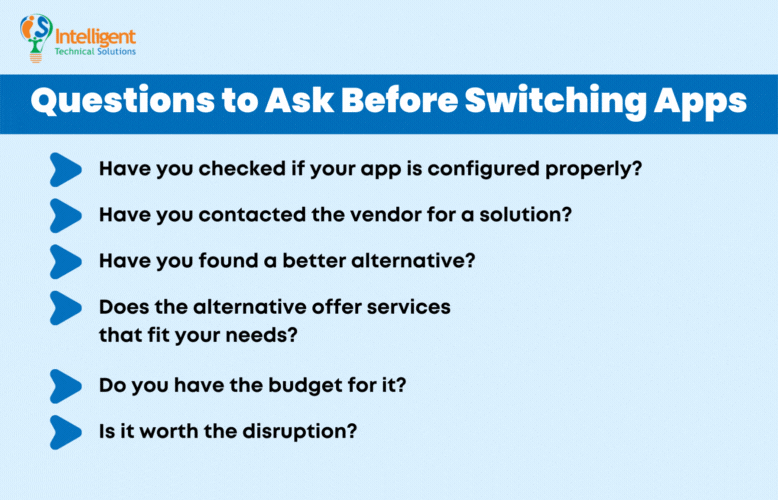What to Do When You're Unhappy with Your Software
August 18th, 2022 | 4 min. read

Imagine trying to hit that project deadline only for your software to decide it's not feeling up for the grind. When your apps can't play the roles you need for your company, it causes more than frustration; it crushes your team's morale and severely hurts productivity. That's when you might want to consider switching to a better alternative.
Unfortunately, breaking up with an office app is a lot like breaking up with a person in the sense that you should never do it impulsively. We're not saying you shouldn't get it over with, especially when the app in question simply can't cut it. However, you should take the time to think it over and avoid that knee-jerk reaction.
The process is not as simple as deleting the app and calling up its competitor. Doing things that way could leave you worse than when you started. In fact, it could be a very costly mistake down the line.
At ITS, we are dedicated to helping businesses like yours make smart decisions and make the most of your technology. We do that by sharing our insights that can help you navigate your tech woes.
In this article, we'll dive into what you need to do and consider before replacing critical software in your business environment.
Things to Consider Before Replacing Critical Apps
It's hard not to get emotional when critical business software causes problems. You might have lost work, time, or even clients because of them. However, it's best to handle this issue rationally. Try to detach yourself from the situation and look at the problem objectively.
According to ITS Director of Operations Peter Swarowski, before switching apps, you would do well to gather a list of your requirements and dissatisfactions with your existing software. He explained that having that information will guide you to what you need to be looking for. "Don't just look for something shiny or something different," he added.
Replacing critical business software can disrupt your operations. The transition alone is already a challenge. Your team will have to re-learn how to work on the new app and develop processes for it. Not to mention, glitches and other unforeseen issues are bound to happen when working with unfamiliar software.
That's why before you hit that uninstall button, you should stop and ask yourself the following questions first:
- Have you checked if your app is configured properly?
- Have you contacted the vendor for a solution?
- Have you found a better alternative?
- Does the alternative offer services that fit your needs?
- Do you have the budget for it?
- Is it worth the disruption?
If you answered yes to all the questions above, then it might be time to make that switch.
What to Do Before Migrating to a New App
Now that you are committed to moving to new software, here comes the tough part: migrating seamlessly. Ensuring your systems can migrate with minimal disruption to your team is a tall order. It's possible, but you'll need some extra effort to get there. Check out some of the things you need to do before migrating to a new app:
Test Before Moving Forward
 You may think you already have your desired app pegged. It seems like the best solution on paper, and the vendor reassures you that it's the best one in the market for your particular needs. Hold that thought. Let's be blunt, you won't always get what's advertised on the box, and a salesperson will likely tell you things you want to hear.
You may think you already have your desired app pegged. It seems like the best solution on paper, and the vendor reassures you that it's the best one in the market for your particular needs. Hold that thought. Let's be blunt, you won't always get what's advertised on the box, and a salesperson will likely tell you things you want to hear.
According to Swarowski, when you talk to a salesperson, they will promise whatever they can to get the sale. They might tell you that an app can perform specific features you need without thinking about how it will impact your operations if the app can't deliver.
Swarowski says to avoid this. “Slow it down and say: show me that it can do those things. Let's do a proof of concept," he said. If they agree with those terms, then you can see how the new app will perform in practice. "Try it out and make sure things are good to go," he added.
Testing whether an app can perform the features you need as advertised is only part of what you should be looking for. Swarowski warns that you also have to think about how that proof of concept will translate when applied to your specific circumstances.
"Sometimes, people will go through a proof of concept, and they'll have just a couple of people try it out, and everything looks good. Then when they move their operations, they realize it doesn't really scale that well. All of a sudden, they're seeing the same problems they had with their old vendor," he says.
Decide What Happens to Your Data
 What will you do with your data? It's a question you need to address before any new software is deployed. According to Swarowski, "there may be some instances where it's very fluid and easy. However, if you have something that's more proprietary like old photo editing software that has its own file format, that might not convert over to this new system."
What will you do with your data? It's a question you need to address before any new software is deployed. According to Swarowski, "there may be some instances where it's very fluid and easy. However, if you have something that's more proprietary like old photo editing software that has its own file format, that might not convert over to this new system."
In instances like those, Swarowski says that you need to determine what path you will take with your data. You can either keep your data as is and move it into the new system, abandon it or seek help from a third party to move it another way.
Ensure Seamless Integration
 Software migration can be tricky because it can also affect other systems you have in place. It's vital to ensure that before deploying new software, your existing systems are compatible with it. While new software is usually built to be compatible with other major vendors, the issue is when you still have legacy programs in your environment. Old and outdated software might not be supported or compatible with new ones.
Software migration can be tricky because it can also affect other systems you have in place. It's vital to ensure that before deploying new software, your existing systems are compatible with it. While new software is usually built to be compatible with other major vendors, the issue is when you still have legacy programs in your environment. Old and outdated software might not be supported or compatible with new ones.
Check whether your legacy programs are compatible. If they are not, you might consider upgrading or updating.
Set It Up for Success
 You might have the best software in the market. However, if you don't know how to configure it for your needs, then you're not getting your money's worth. Good software requires some setting up, which can be a challenge for smaller companies that don't have the manpower and expertise.
You might have the best software in the market. However, if you don't know how to configure it for your needs, then you're not getting your money's worth. Good software requires some setting up, which can be a challenge for smaller companies that don't have the manpower and expertise.
"Capable software can do all kinds of things, but out of the box, it doesn't really do anything. You have to custom configure it in order for it to actually do something sophisticated," Swarowski says.
Thankfully, you don't have to do it alone. You can seek help from experts to help you get the most out of your new software. A reliable managed service provider can help you navigate the pitfalls and overcome software migration issues.
Ready to Migrate to New Software?
It's frustrating when your business software fails, but don't jump the gun when deciding to call it quits. Take the time to ensure a software migration is the best choice for your business. If it is, then you need to do a few things before you commit:
- Test the app
- Figure out what will happen to your data
- Ensure its compatibility with existing systems
- Learn how to set it up
At ITS, we've helped hundreds of businesses make the most of their technology and navigate challenges like software migration by sharing useful insights. To learn more about how managed IT can help you, check out our article titled 3 Ways Managed Services Supports your IT Team.
Mark Sheldon Villanueva has over a decade of experience creating engaging content for companies based in Asia, Australia and North America. He has produced all manner of creative content for small local businesses and large multinational corporations that span a wide variety of industries. Mark also used to work as a content team leader for an award-winning digital marketing agency based in Singapore.
Topics:

